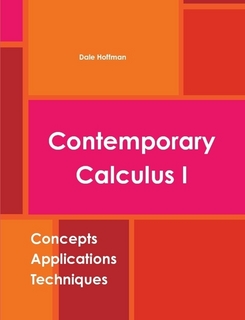
Contemporary Calculus I

This is a textbook for differential calculus with explanations, examples, worked solutions, problem sets and answers. It has been reviewed by calculus instructors and class-tested by them and the author.
Topics are typically introduced by way of applications, and the text contains the usual theorems and techniques of a first course in calculus. Besides technique practice and applications of the techniques, the examples and problem sets are also designed to help students develop a visual and conceptual understanding of the main ideas of differential calculus.
This is the first of a three-part calculus series. The others are available on the author's website
License: Creative Commons Attribution. This license is considered to be some to be the most open license since it is the least restrictive. It allows reuse, remixing, and distribution (including commercial), only requiring attribution. The content can be remixed into content of other license, but on the other hand it allows the remix to be put under a more restrictive license.
Formats:
- DOC. A DOC file can be opened using Microsoft Word or OpenOffice.org. It is an editable format
- PDF. A Portable Document Format (PDF) file is can be opened using the free Acrobat Reader. It is not an editable format.
Openness Rating (0-4): 4
Openness Comments: Word version is available via email from the author.
- Chapter 0: Preview and Review
- 0.1 Preview of Calculus
- 0.2 Lines in the Plane
- 0.3 Functions and Their Graphs
- 0.4 Combinations of Functions
- 0.5 Mathematical Language
- Chapter 1: Functions, Graphs, Limits and Continuity
- 1.0 Tangent Lines, Velocities, Growth
- 1.1 The Limit of a Function
- 1.2 Properties of Limits
- 1.3 Continuous Functions
- 1.4 Definition of Limit
- Chapter 2: Derivatives
- 2.0 Introduction to Derivatives
- 2.1 The Definition of Derivative
- 2.2 Derivatives: Properties and Formulas
- 2.3 More Differentiation Patterns
- 2.4 The Chain Rule
- 2.5 Some Applications of the Chain Rule
- 2.6 Related Rates: An Application of Derivatives
- 2.7 Newton's Method for Finding Roots
- 2.8 Linear Approximation and Differentials
- 2.9 Implicit and Logarithmic Differentiation
- Chapter 3: Derivatives and Graphs
- 3.1 Finding Maximums and Minimums
- 3.2 The Mean Value Theorem and Its Consequences
- 3.3 The First Derivative and the Shape of f
- 3.4 Second Derivative and the Shape of f
- 3.5 Applied Maximum and Minimum Problems
- 3.6 Infinite Limits and Asymptotes
- 3.7 L'Hopital's Rule
Supplements: None